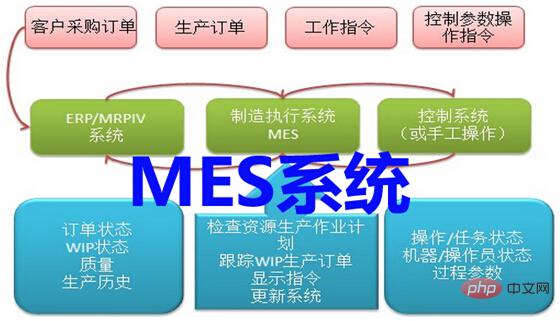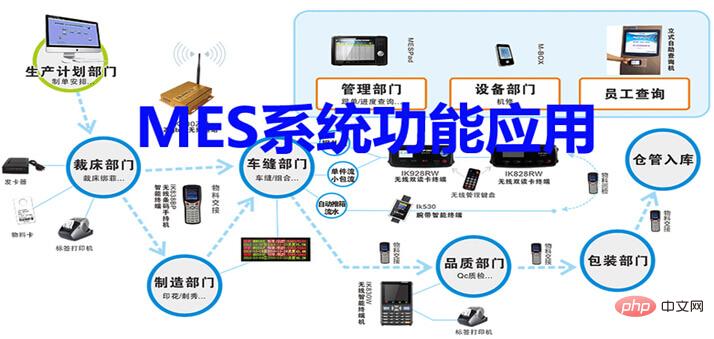
Core functions: 1. Resource allocation and status management, which can manage machine tools, tools, personnel and materials, other equipment, etc., to meet the requirements of the production plan and schedule them to ensure the normal progress of production. ; 2. Detailed scheduling of processes to achieve a good work sequence and minimize preparation time in the production process; 3. Production unit allocation, manage the workflow between production units in the form of jobs, orders, batches, batches and work orders. ; 4. Process management, monitoring the production process, automatically correcting errors in production and providing decision support to users to improve production efficiency.

The operating environment of this tutorial: Windows 7 system, Dell G3 computer.
The full name of the mes system is "manufacturing execution system", which means "manufacturing execution system" in Chinese. It was proposed by the American AMR Company (Advanced Manufacturing Research, Inc.) in the early 1990s to strengthen the execution of the MRP plan. The function links the MRP plan with the workshop operation site control through the execution system. The on-site control here includes PLC program controllers, data collectors, barcodes, various measuring and testing instruments, manipulators, etc. The MES system sets up the necessary interfaces and establishes cooperative relationships with manufacturers that provide production site control facilities.

mes The core functions of the system
1. Resource Allocation and Status Management (ResourceAllocationandStatus )
This function manages machine tools, tools, personnel and materials, other equipment and other production entities to meet the requirements of the production plan and schedule them to ensure the normal progress of production; provide resources Usage history and real-time status information ensure equipment is installed and operating correctly.
2. Operations/DetailScheduling
This function provides priorities (Priorities) and attributes (Attributes) related to the specified production unit. , characteristics (Chameterietioa) and recipes (Recipes), etc., through scheduling based on limited capacity, by considering interleaved, overlapping and parallel operations in production to accurately calculate equipment loading, unloading and adjustment time, achieve good operation sequence, and minimize Lead time during production.
3. DispatchingProductionUnits
This function manages the workflow between production units in the form of jobs, orders, batches, batches and work orders. By adjusting the production schedule established by the workshop, the repaired products and scrap products are processed, and the quantity of work-in-progress at any location is controlled using the buffer management method. When an event occurs in the workshop, a certain sequence of scheduling information must be provided and related real-time operations must be performed accordingly.
4. Process Management
This function monitors the production process, automatically corrects errors in production and provides decision support to users to improve production efficiency. By continuously tracking the production operation process, some relatively low-level operations are implemented on the monitored and controlled machines; through the alarm function, workshop personnel can promptly detect that the processing process exceeds the allowable error; through the data collection interface, intelligent Data exchange between equipment and manufacturing execution systems.
5. Human Resources Management (Labor Management)
This function provides the status of each person in divided units. Through time comparison, attendance report, behavior tracking and behavior (including asset and tool preparation operations)-based expense as a benchmark, the ability to track the indirect behavior of human resources is achieved.
6. Maintenance Management (Maintenance Management)
This function is used to instruct and track the maintenance behavior of equipment and tools to improve production and schedule management capabilities, and to implement equipment and tools optimal utilization efficiency.
7. Plan management (ProcessControl)
This function is to monitor production and provide support for the discussion and decision-making of workers in progress, or automatic modification. Such actions focus on machinery and equipment that work internally or plan to track, monitor, control and work from one operation to the next; include planning from the outside in order to let the operator and everyone know the allowable error range Change alert management.
8. Document Control (DocumentControl)
This function controls, manages and transmits work instructions, formulas, engineering drawings, standard process procedures and parts related to the production unit. CNC machining programs, batch processing records, engineering change notifications, and communication records between various conversion operations, and provide information editing and storage functions. Instructions such as providing operating data to the operator or providing production recipes to the equipment control layer are issued to the operator. layer, including the control and integrity maintenance of other important data (such as data related to environmental, health and safety systems and ISO information).
9. Product Tracking and Genealogy
Эта функция позволяет увидеть местоположение задания и место его завершения. Благодаря информации о состоянии вы можете понять, кто работает, активы поставщика, соответствующие серийные номера, текущие производственные условия, статус сигнализации и другие вопросы, связанные с производством. после повторной операции. .
10. Анализ производительности
Эта функция предоставляет фактические результаты выполнения заданий, представленные в единицах, путем сравнения прошлых записей и ожидаемых результатов. Результаты анализа выполнения включают тестовые значения использования ресурсов, доступности ресурсов, времени цикла производственной единицы, соблюдения графика и соответствия стандартам. Чтобы конкретизировать информацию, полученную в результате тестирования множества разрозненных функций фактора задания, такие результаты должны быть подготовлены в форме отчетов или доступны в Интернете, чтобы обеспечить оценку выполнения в реальном времени.
11. Сбор/сбор данных
#Эта функция получает и обновляет различные данные и параметры, связанные с функцией управления производством, через интерфейс сбора данных, включая отслеживание продукции, ведение история продукта и другие параметры. Эти полевые данные можно ввести вручную из мастерской или получить с помощью различных автоматических методов.

Для получения дополнительной информации посетите колонку FAQ!
The above is the detailed content of What are the core functions of the mes system?. For more information, please follow other related articles on the PHP Chinese website!